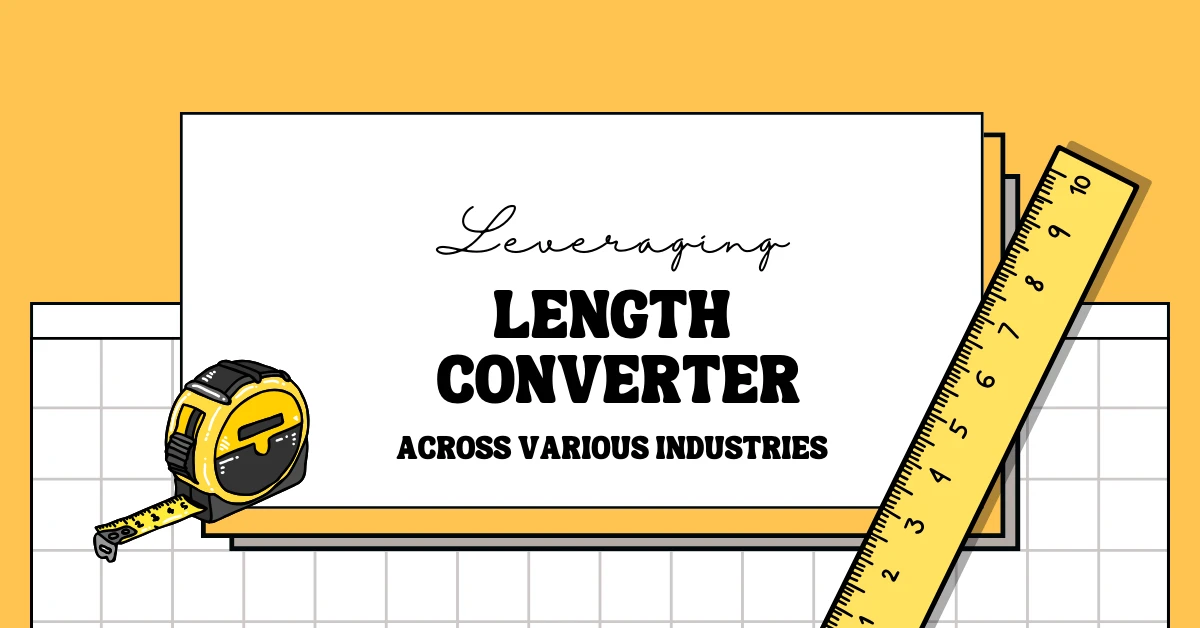
Leveraging Length Converter Across Apparel, Construction and Other Key Industries
A length converter is an online tool that helps precisely calculate length measurements. It's an important tool for various industries such as apparel, construction, manufacturing, maritime, and several others. Industries are required to calculate various length measurements relevant to their specific job functions.
The apparel industry needs this tool for accurate measurements for garment production. The construction industry utilizes the length converter tool for completing projects with accurate measurements. Similarly, other industries utilize the tool according to their job functions.
Key Takeaways
- Understand what a length converter is and essential length measurement units.
- Understand key industries and the integration of a length converter tool in their business function.
Understand the Length Converter Tool
A length converter like the one Smart Tools AI offers is an online tool that helps convert different length measuring units. This tool is helpful to quickly and accurately calculate different length units. This is essential for various business applications.
Some common length measurement units are:
- Centimeter: A common length measuring unit that equals 0.01 meters.
- Decimeter: This unit is also common where one decimeter equals 10 centimeters.
- Meter: A most commonly used length measuring unit in different industries. One meter equals 100 centimeters.
- Inch: A unit that is often used for length measurements. One inch equals 2.54 centimeters.
- Foot: This is an imperial unit that equals 12 inches.
- Micrometer: This unit is used for micro-length measurement. One million micrometers equal a meter.
- Kilometer: This unit is used to measure long distances. One kilometer equals 1000 meters.
- Mile: Same as kilometers, used to measure long distances. One mile equals 1.609 kilometers.
- Millimeter: Again, a micro-measuring unit. 1000 millimeters equals one meter.
- Yard: Another crucial unit in length measurement equal to 3 feet.
- Caliber: 1200 caliber equals a foot.
- Fathom: A nautical unit. One fathom equals six feet.
- Furlong: A unit of distance that equals 0.125 miles.
These are some common length measurement units that the length converter offers. Additionally, there are some other units available in the tool such as Ell, Em, Angstrom, Fermi, League, Light year, Picometer, Nanometer, Astronomical unit, Parsec, Point, Pica, and Rod which are useful for industry applications.
Anyone can leverage the power of this tool to convert their desired length units accurately. It's convenient to use and effectively displays the conversion units on the top. So, business owners and industry professionals can utilize this tool easily for their specific needs.
01. Length Converter in Apparel Industry

Importance of Accurate Measurements in Garment Production
Accurate length measurement is crucial for perfect garment production. This ensures a good fit of products that enhance customer satisfaction. Also, offering perfect products with a good fit can enhance a business's reputation.
In the apparel industry, different sizes are used for garment length measurements. Each product comes with unique length measurements. For example, measuring the inseam length is important for producing good-fit trousers. Similarly, sleeve length measurement is important for shirts, tops, and other product fittings.
In this case, converting different length units is an essential requirement. Thus, the apparel industry utilizes the length converter tool to fulfill this purpose.
Examples of How Apparel Companies Benefit from Using Length Converter
Using the tool helps precisely measure various units and improve product quality. This is directly proportionate to customer satisfaction and brand reputation. Here is an example:
An apparel company operates in both the US and UK markets. In the US, the standard measurement for garment lengths is measured in inches, while in the UK, the standard measurement is in centimeters. The manufacturing team of the company leverages the length converter tool to easily transit between these two measurement systems.
For instance, when the company designs a new set of jeans, the manufacturing team makes sure that the inseam length is accurately measured and converted between inches and centimeters. This let the company maintain consistency in sizing across both markets. Also, it ensures that customers in the US and UK obtain garments with the correct inseam length relative to their respective measurement preferences.
Additionally, the length converter tool helps in fulfilling orders for international customers. The manufacturing team can easily convert garment measurements between inches and centimeters using the tool. This can ensure that customers worldwide get perfect jeans with accurate measurements.
02. Length Converter in Construction Industry

Need for Precise Measurements in Construction Projects
Completing construction projects involves precise measurements of different lengths. Accurate length measurement is crucial here to avoid costly mistakes. A length converter tool is useful for measuring various lengths of construction projects in different units.
In construction projects, calculating the distances between structural elements requires accurate length measurement. Plus, this measurement is vital for selecting suitable materials where proper material size is an important aspect for good construction.
Mostly different length units are used in construction projects such as meters, feet, inches, etc. For a clear understanding of design parameters and structural elements, the length converter is used. Also, our area converter is an other useful tool for the construction industry.
Role of Length Converter in Ensuring Accuracy in Building Dimensions
As the construction industry uses different length measuring units, ensuring accuracy is important. For this purpose, a length converter tool is helpful which converts different units accurately. For example:
An architect developed a design plan for a construction project using foot measurement. To ensure accuracy while constructing the building, structural engineers need to convert the feet units into various other units like centimeters, meters, yards, and inches. This helps construction workers easily understand different measurements in different units.
Moreover, ensuring accuracy in building dimensions is crucial for calculating the costs accurately. Most of the contractors determine the price based on square feet or meters and inaccuracies in length measurements can lead to potential losses to the project owner.
03. Length Converter in the Manufacturing Sector

Importance of Precise Measurements in Manufacturing Processes
In manufacturing sectors length converter plays a vital role in ensuring good quality product outputs. Several products require accurate length measurements. So, precisely informing industrial machinery and workforce of the specification of product lengths is essential.
Moreover, precise length measurement helps reduce unnecessary waste in production. This aids in reducing production costs and enhancing overall productivity. In the production process, different length measurement units are used. According to the type of product, converting accurate length metrics is vital and the tool is super helpful for this purpose.
Examples of Manufacturing Industries Benefiting from Length Converter
Manufacturing industries receive huge benefits from the use of Length Converter tools. For example, in the automotive industry, accurate length measurement is crucial for fabricating engine components and other parts like chassis, and vehicle interiors. This ensures accuracy in the production of automotive parts and assemblies.
Similarly, in the electronics manufacturing sector, electronic components are manufactured to exact specifications. Here, the tool helps facilitate precise conversions between units like millimeters and inches. This approach contributes to the efficient production of electronic devices such as smartphones, and circuit boards.
04. Length Converter in Maritime Industry

Importance of Precise Measurements in Maritime
Precise length measurement is crucial in the maritime industry for various aspects such as designing a vessel, building it, and for navigational purposes. Accurately measuring the ship dimensions like length, width, and draft can ensure optimal vessel performance. It also ensures stability, and safety at sea.
In addition to this, shipbuilders use length converters for precisely measuring various length units to design and construct vessels that meet vital regulatory standards and other operational requirements.
Further, the safe and efficient transportation of goods is a crucial responsibility in the maritime industry. To ensure this, maritime logistics leverage the tool for precise length measurements of shipping containers, ports, and navigational routes.
Example of Maritime Industry Benefitting from Length Converter
The tool is useful for converting important length measurement units related to the maritime industry, such as nautical miles, miles, kilometers, etc. For example, a shipping company requires accurate distance measurements between two ports for their route planning purposes. Their vessels generally measure distances in nautical miles, but the ports' locations are in kilometers.
In this case, using the length converter tool helps the shipping company to convert the distance between the two ports from kilometers to nautical miles. The distance between the ports is identified as 200 kilometers as an example, which is equivalent to the:
200 kilometers * 0.53996 nautical miles per kilometer = 107.992 nautical miles
So, the shipping company could able to determine the distance between the two ports as approximately 108 nautical miles. This allows them to plan their maritime routes accurately.
Wrapping Up
Accurate length measurement is a vital aspect of various industries. Inaccurate calculations may lead to potential issues and losses. Therefore, many industries leverage the length converter for accurate and quick length conversions and measurements.
Industries like apparel, construction, manufacturing, and maritime are effectively using the tool for their business purposes. In addition to these crucial industries, some other important sectors utilize length converters in their operations, such as the automotive, aerospace, and agriculture sectors.
FAQ
Q1: How many nautical miles equal one kilometer?
Approximately 0.54 nautical miles equals one kilometer. In other words, one nautical mile is equivalent to 1.852 kilometers.
Q2: How many yards are in a mile?
If we convert miles to yards, in a mile, there are 1760 yards.
Q3: How many inches are in a yard?
If we take inches concerning yards, there are 36 inches in one yard.
Q4: How many inches are in a meter?
When we convert inches to meters, there are 39.37 inches in one meter.
Q5: How many feet are in a mile?
There are a total of 5280 feet in one US statute mile.
Q6: How many feet are 60 inches?
When we convert 60 inches to feet, there are a total of 5 feet which is equivalent to 60 inches. One foot equals 12 inches.
Q7: How many meters in a mile?
There are a total of 1609.34 meters in one mile.
Explore Related Posts
https://smarttoolsai.com/post/warehouse-logistics-area-converter
.webp)